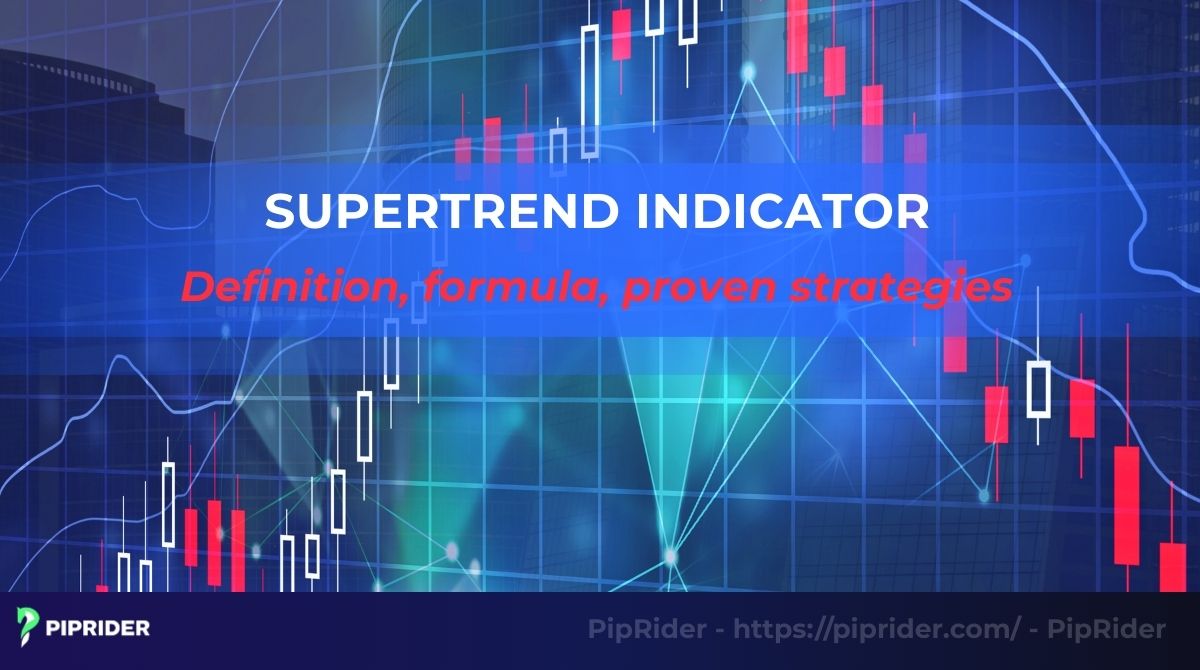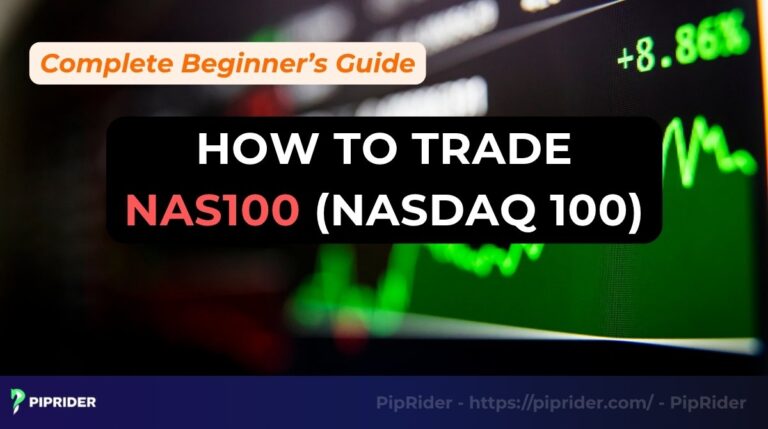Precise trend identification and volatility management are critical components of a successful trading system. The Supertrend indicator offers a systematic solution by smoothing out price fluctuations to highlight the dominant market direction. Widely favored for its ability to filter out noise, this tool is particularly effective in trending markets.
This guide offers a complete breakdown of the Supertrend formula, its operational mechanics, and proven strategies to enhance trading discipline and accuracy.
Key Takeaways
- The Supertrend indicator uses a single line to determine the market’s direction.
- The green line below the price points to an uptrend, whereas the red line above the price points to a downtrend.
- Two main settings: ATR Period and Multiplier control the indicator’s sensitivity.
- It works well in trending markets but can produce wrong signals in sideways or ranging markets.
- For best results, the Supertrend should be combined with other indicators to confirm signals and filter out noise.
1. What Is The Supertrend Indicator?
The Supertrend indicator is a technical analysis tool designed to identify the primary direction of the market trend. It is plotted as a single line directly on the price charts, making it one of the most visual and easy-to-interpret stock trend indicators available.This indicator combines the Average True Range (ATR) and price to determine the trend.
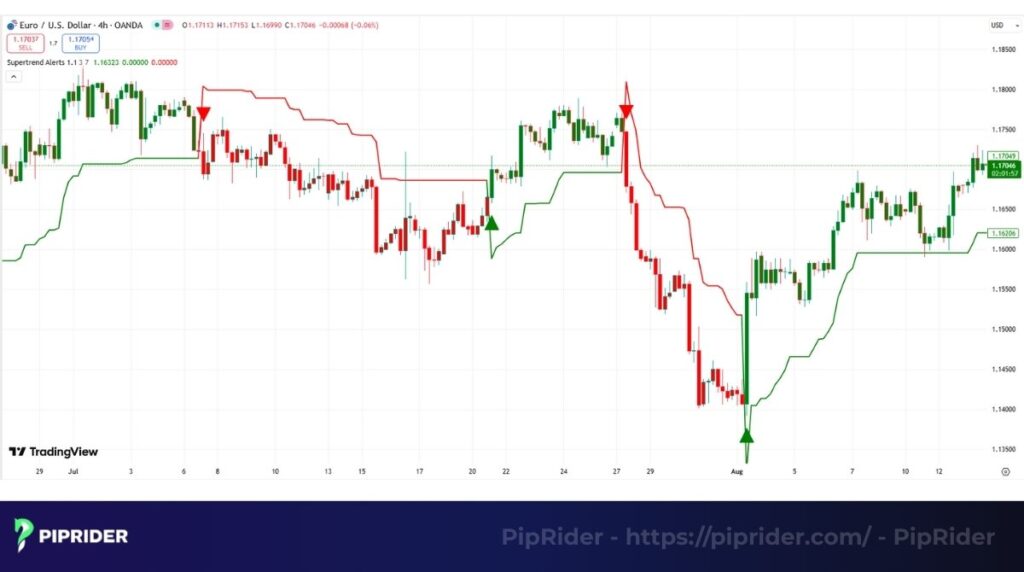
The Supertrend was developed by French author and trader Olivier Seban, in 2009 (Investopedia, 2023) and has become extremely popular across all asset classes, including stocks, forex trading, and crypto, due to its simplicity and effectiveness.
The main purpose of the Supertrend is to provide clear, unambiguous signals for trend direction. Unlike a simple moving average, the Supertrend line dynamically adjusts its distance from the price based on the market’s current volatility, making it a superior market trend indicator for many traders.
The Supertrend indicator automatically tracks the price and gives traders a clear, color-coded signal when the trend changes. The line switches from support to resistance, helping traders know when to be bullish and when to be bearish. Because of its clear rules, it’s a popular choice for those building a trade algorithm indicator.
Read more:
15 best technical indicators 2025: Beginner guide
Directional Movement Indicator (DMI): Definition & Strategies
2. How does the Supertrend indicator work?
At its core, the Supertrend indicator works by plotting a single, adaptive line directly onto the price chart. This line’s primary job is to serve as a dynamic level of either support or resistance levels, clearly defining the current market trend.
The intelligence behind this line comes from its use of market volatility. The indicator takes the Average True Range to measure the market’s choppiness. This is then used to apply a Multiplier, creating a “buffer zone” around the price. In volatile periods, this buffer is wide; in calm periods, it’s narrow.
The final output is a simple, color-coded boundary that serves as either trailing support or resistance. A green line below the price signals an uptrend, while a red line above the price indicates a downtrend. The line only “flips” its position and color when the price makes a decisive close on the other side.
3. Components of the Supertrend Indicator
The Supertrend indicator is built from two primary components that control its entire behavior: the ATR period and the multiplier. These two settings work together to create the indicator’s single, powerful trend line.

3.1. The core settings: ATR period and multiplier
The image above shows there are the only two “dials” traders can turn, and they control the entire behavior of the indicator.
- The Period: Think of this as the indicator’s “memory.” The setting determines how many recent candles (the default is 10) the indicator uses to calculate current market volatility. A shorter period leads to a faster reaction to recent events, while a longer period provides a smoother, more stable reading.
- The Multiplier: The multiplier acts as the indicator’s sensitivity setting, creating a “buffer zone” around the price by multiplying the ATR value (the default is 3). A smaller value provides faster signals with a “tighter” line, while a larger value yields a “looser” line for slower but more reliable trade setups.
3.2. The hidden components: The upper and lower bands
One of the most interesting things about the Supertrend is that the line traders see is only half the story. At all times, the indicator is calculating two invisible lines in the background.
- The Upper Band: An upper boundary that acts as potential dynamic resistance, calculated by adding the volatility buffer (ATR x Multiplier) to the average price.
- The Lower Band: A lower boundary that acts as potential dynamic support, calculated by subtracting the volatility buffer (ATR x Multiplier) from the average price.
The single Supertrend line displayed on the chart is always one of these two hidden bands.
3.3. How price interacts with the Supertrend line
So how does the indicator decide which of these hidden bands to show traders?
- During an uptrend, the indicator exclusively plots the lower (green) band, completely ignoring the upper band.
- Conversely, a downtrend will only display the upper (red) band while the lower one remains hidden.
A “flip,” or change in trend, only occurs when a candle closes decisively on the opposite side of the active line. For instance, if a candle crosses below the green support line during an uptrend, the trend is broken. The indicator’s color and position will then reverse on the next candle, and the red resistance line will appear.
4. Supertrend indicator formula and calculation
The Supertrend’s brilliance lies in its ability to transform a simple mathematical concept into an incredibly intuitive visual guide. While manual calculation is unnecessary, understanding the Supertrend indicator’s formula is crucial for appreciating how the indicator functions.
The entire process involves two main steps: first, calculating the initial “basic band” levels, and second, applying a specific logic to determine which band becomes the active Supertrend line.
4.1. The basic band formulas
The supertrend indicator initially calculates two preliminary bands for each candle. These are like dynamic channels that constantly adjust to price.
Here are the formulas for these basic bands:
| Upper Band = [(High + Low) / 2] + (ATR x Multiplier) Lower Band = [(High + Low) / 2] – (ATR x Multiplier) |
Where:
- (High + Low) / 2 is the typical price or midpoint of the candle.
- Multiplier is your chosen sensitivity setting (e.g., 3).
4.2. The calculation process in simple steps
The real intelligence of the Supertrend lies in its method for combining these basic bands. The indicator is specifically designed to remain on one side of the price until a confirmed break occurs.
Step 1: Calculate the ATR
The process begins by calculating it for each candle based on the chosen period (e.g., 10).
Step 2: Calculate the basic bands
Using the newly calculated ATR and the specified multiplier, the indicator then determines the Upper and Lower Band values for that candle.
Step 3: Apply the trend logic
This final, crucial step is what gives the Supertrend its characteristic “stickiness”.
- The Supertrend’s appearance changes based on the market’s trend. In an uptrend, a green Lower Band provides a support point. For a flip to a downtrend, the price must decisively cross and break below it.
- Conversely, in a downtrend, a red Upper Band provides a resistance point. A confirmed reversal is signaled by a decisive break above that same band.
4.3. A simple example of the calculation
To make this crystal clear, let’s look at how the basic bands are calculated for a single candle, ignoring the complex “flip” logic for a moment. This will help you understand the core mechanics.
Let’s assume the following for a single candle on the GBP/USD chart with the default settings (10, 3):
- High of the candle = 1.2550
- Low of the candle = 1.2500
- Current ATR(10) value = 0.0020 (20 pips)
- Multiplier = 3
Now, we just plug these numbers into the basic formulas:
Step 1: Calculate the midpoint price
| Midpoint = (1.2550 + 1.2500) / 2 = 1.2525 |
Step 2: Calculate the ATR component
| ATR Component = 0.0020 (ATR) x 3 (Multiplier) = 0.0060 |
Step 3: Calculate the final bands
| Upper Band = 1.2525 + 0.0060 = 1.2585 Lower Band = 1.2525 – 0.0060 = 1.2465 |
So, for this specific candle, the indicator’s two hidden bands are at 1.2585 and 1.2465. The Supertrend will then decide which of these (or a previous value) to display on the chart based on whether the price is currently in an uptrend or a downtrend.
5. How to use the Supertrend indicator in trading
The best part about the Supertrend is that its signals are incredibly simple and visual. However, seeing a signal and knowing how to trade it are two different things. Let’s walk through the practical steps you can take after the indicator gives you a signal, from entry to risk management and trade management.
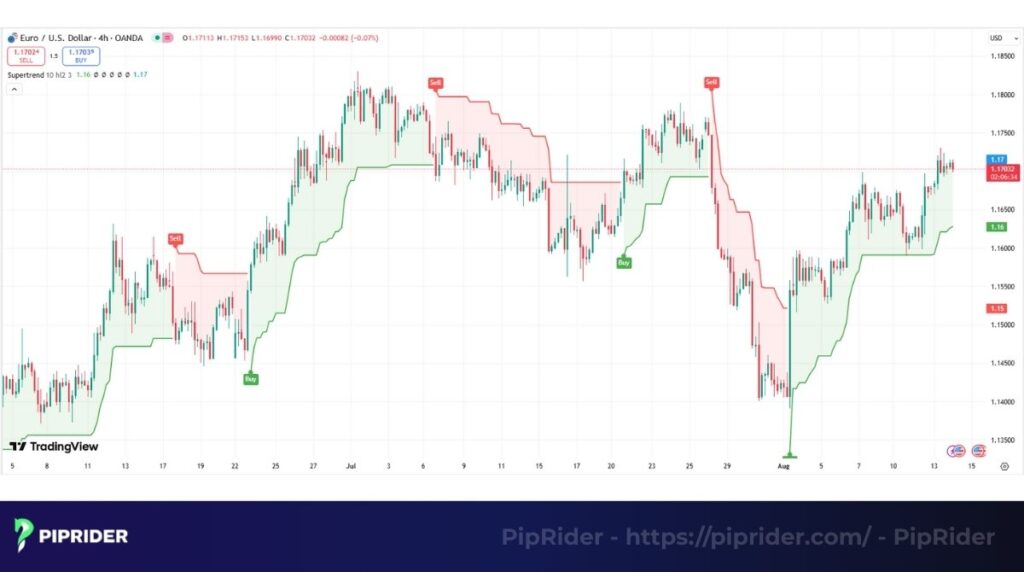
5.1. Trading the buy signal
Based on the chart above, a buy signal is your cue that the market’s momentum has likely shifted from bearish to bullish. Let’s break down how to trade this setup effectively.
- The signal: A buy signal is triggered when a bar closes decisively above the red Supertrend line. This action causes the indicator to flip to green on the subsequent bar.
- Actionable steps:
- Entry: The standard approach is to enter a buy order at the opening price of the bar immediately following the flip.
- Stop loss: Traders have two logical choices for an initial stop loss. The more aggressive option is just below the low of the breakout bar, while a more conservative option is just below the new green Supertrend.
- Trade management: As price moves favorably, the green Supertrend will trail behind it, serving as an effective dynamic trailing stop. A position is typically held until a bar eventually closes below it. This dynamic trailing stop helps traders identify optimal exit points.
5.2. Trading the sell signal
Conversely, a sell signal indicates that the bears have likely taken control of the market.
- The signal: The sell signal occurs when a bar closes decisively below the green Supertrend, causing it to flip to red on the next bar.
- Actionable steps:
- Entry: A sell order can be placed at the opening price of the bar that follows the flip.
- Stop loss: The initial stop can be positioned either just above the high of the breakdown bar or slightly above the new red Supertrend.
- Trade management: The short trade is held as long as the red Supertrend remains above the price. An exit signal is triggered when a bar finally closes back above this red boundary.
5.3. Important notes on lag and false signals
While the signals are simple, understanding the indicator’s limitations is crucial for long-term success.
Note 1: Inherent lag
The Supertrend is always reactive. It will only signal a trend change after a significant price movements has already occurred. The indicator’s design means it will never catch the absolute peak or trough; its goal is to capture the main body of the trend.
Note 2: Vulnerability to whipsaws
The indicator’s biggest weakness is its poor performance in sideways market conditions. When a market lacks a clear trend, the price will constantly “whipsaw” across the line, generating a series of frustrating and costly wrong signals. For this reason, a trader must always use a secondary tool, such as a long-term EMA or the ADX, to confirm that a tradable trend is actually in place.
6. Best Supertrend indicator settings for different styles
While the default settings of (10, 3) are a fantastic starting point, one of the Supertrend’s greatest strengths is its flexibility. Adjusting the Period and Multiplier allows a trader to fine-tune the indicator’s sensitivity to match a specific trading style and time frames.
This adjustment always involves a trade-off: a faster setting will produce earlier signals with more noise, while a slower setting generates fewer signals with higher reliability.
The Supertrend indicator can be used on any of the major trading platforms that supports custom indicators.
| Trading style | ATR period | Multiplier | Common time frames | Reasons |
| Scalping | 7 | 2–3 | 1-minute, 5-minute | For scalping, speed is everything. A shorter period makes the indicator react instantly to small price moves, but this comes with a high risk of false signals. |
| Intraday Trading | 7–10 | 2–3 | 15-minute, 1-hour | This range is often considered the ideal balance for many intraday traders. Using the default 10, 3 or a slightly faster 7, 2 on an hourly chart provides a great balance, capturing the main session trends without getting shaken out by minor noise. |
| Swing Trading | 10–14 | 3–4 | 4-hour, Daily | For swing trading, reliability is more important than speed. A setting like 14, 3 or even 12, 4 on a daily chart will help you stay in a trend for several days or weeks, filtering out the volatility. |
Important note: The platforms mentioned are just examples of where these styles are popular. The Supertrend indicator can be used on any platform that supports custom indicators.
Whether trader are looking for the Supertrend indicator on Webull, Thinkorswim, or as a NinjaTrader 8 script, the principles of adjusting these settings remain the same. This also applies to the Metatrader 4 version (often called the Supertrend for MT4).
7. Intraday trading strategies using Supertrend
The Supertrend is a favorite among intraday traders due to its clarity and simplicity. Let’s break down four distinct strategies traders can use to find and manage trades within a single trading session.
7.1. Strategy 1: The basic Supertrend breakout
The basic Supertrend breakout is the most straightforward way to use the indicator, acting directly on its primary signal.
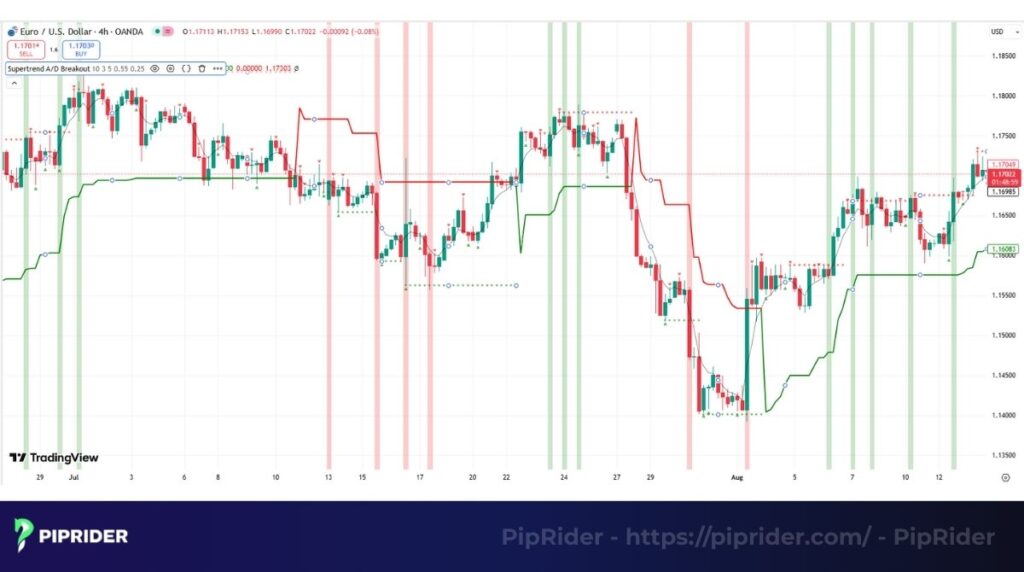
Treat the flip of the Supertrend line as a direct signal that the short-term trend has changed, and we enter as the new trend begins.
The rules for a buy trade:
- The signal: Wait for a candle to close above the red Supertrend indicator, causing it to flip to a long signal.
- Entry: A buy order should be placed at opening price of a subsequent bar.
- Stop loss: Position a stop either just under a breakout bar’s low or beneath a newly formed uptrend indicator boundary.
7.2. Strategy 2: The Supertrend pullback
The Supertrend pullback is a more conservative and, in my opinion, a higher-probability strategy. Instead of entering on the initial breakout, we wait for the first successful test of the new trend.

After a new trend is established, the price will often pull back to test the Supertrend line, which is now acting as dynamic support or resistance levels. Traders enter on this retest.
The rules for a buy trade:
- Establish the trend: The indicator must be in an uptrend and below the price.
- Wait for the pullback: Allow the price to correct downwards and make contact with the indicator’s line.
- Confirm the bounce: Look for a positive candlestick pattern to form right at the indicator’s line.
- Entry: Enter a long trade after the confirmation candle closes. Traders can place their stop just under the low point of this candle.
7.3. Strategy 3: The Supertrend range break
This strategy uses the Supertrend to confirm a decisive market move from a period of consolidation.
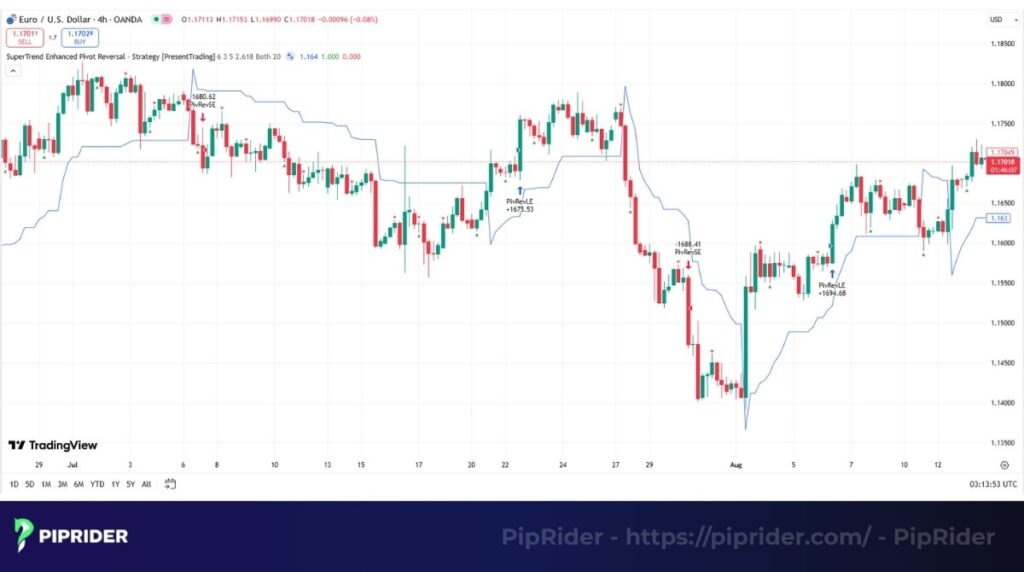
A market often consolidates in a tight range before its next big move. Use the indicator’s flip as our confirmation that the breakout is real and a new trend is starting.
The rules for a buy trade:
- Identify the range: Draw support and resistance lines around a clear sideways channel.
- Wait for the price breakout: Watch for a candle to close decisively above the range’s resistance.
- Confirm with Supertrend: The indicator must flip from red to green either on the breakout candle or within the next 1-2 bars. This is your final confirmation.
- Entry: Enter after the Supertrend has flipped to green.
7.4. Strategy 4: The Supertrend reversal
The Supertrend reversal is the most aggressive strategy and is essentially the same as the “Basic Breakout” (Strategy 1). The key difference is the trader’s mindset and objective.
Here, the trader is specifically looking to catch the exact moment a trend reverses. They are not waiting for confirmation but are acting immediately on the indicator’s signal flip.
Case Study: A textbook example of this occurred on June 13, 2024, right after the release of the US Producer Price Index (PPI) data.
Leading into the 8:30 AM (EST) news release, the EUR/USD was in a clear intraday downtrend on the M15 chart, trading consistently below its red Supertrend (10, 3) line. The PPI data came in significantly weaker than forecast, signaling lower inflation and causing an immediate spike in EUR/USD.
A single, large bullish candle at 8:30 AM EST closed decisively above the red Supertrend line (around 1.0815), causing the indicator to flip to green. An aggressive reversal trader, ignoring priorsell signals, would enter a buy order immediately on the next candle, placing a stop below the low of that large candle, betting on a complete trend reversal.
With a stop loss placed below the low of that news candle (around 1.0785), the trade represented a high-risk, high-reward bet on a complete session trend reversal. In this real-world instance, the reversal was powerful, carrying the price towards 1.0850 over the next few hours.
8. Swing trading and long-term strategies using Supertrend
The Supertrend’s utility extends beyond just intraday trading. Its ability to track a trend makes it incredibly valuable for swing and position traders who hold trades for days, weeks, or even months.
For these styles, the key is to pair the Supertrend with other tools to focus on the big picture and filter out short-term noise.
8.1. Strategy 1: The Supertrend trend-following system
The Supertrend trend-following system is a time-tested and solid strategy created to ensure you are trading in alignment with the primary market trend.
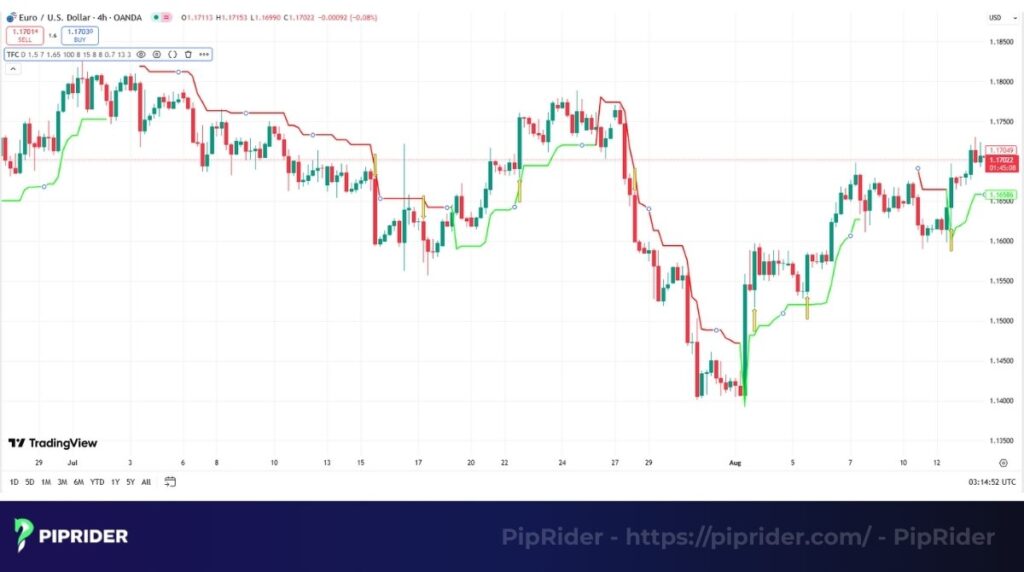
Use a long-period moving average, like the 100-period or 200-period EMA, as the primary trend filter. The Supertrend is then used as the entry and exit trigger, but traders only take signals that align with the direction of the main EMA.
The rules for a long position:
- Primary trend: The first condition is that price must be positioned above the 200 EMA on the daily chart.
- Entry signal: A long position is triggered when the Supertrend indicator on the chart changes from red to green.
- Exit signal (Trailing Stop): Traders should remain in the trade as long as the green Supertrend continues to display. An exit is triggered only after a candle closes beneath the indicator, which will cause it to turn crimson.
8.2. Strategy 2: The Supertrend breakout confirmation
This strategy uses the Supertrend to confirm a decisive market move from a major consolidation pattern, like a multi-week triangle or range.
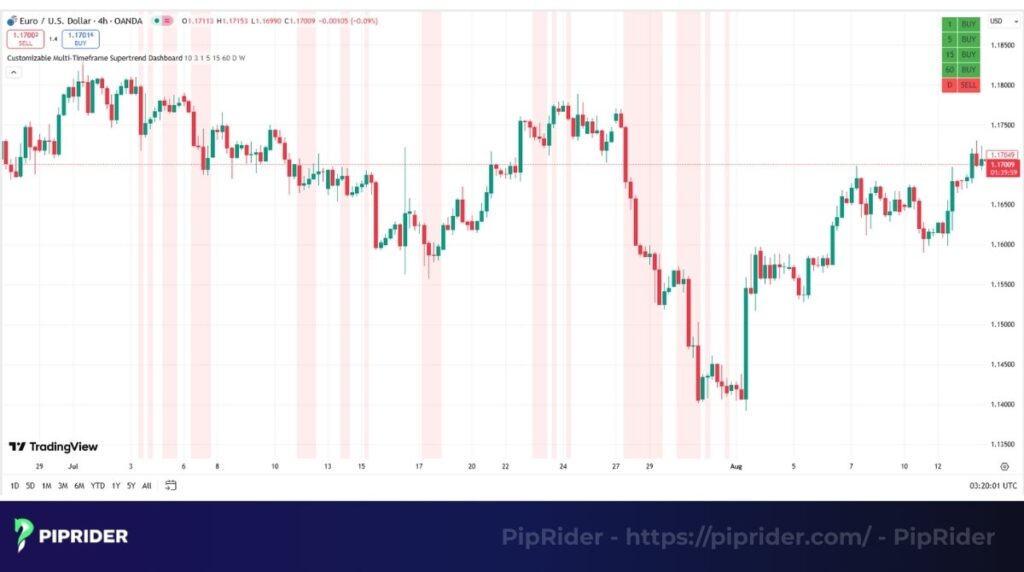
A move out of a major consolidation on a daily or weekly chart is a significant event. The Supertrend’s flip serves as the final, objective validation that the breakout is legitimate and a new, powerful trend is underway.
The process:
- Identify the pattern: Find a clear consolidation formation on a high time frame chart.
- Wait for the price breakout: Monitor the chart for a daily candle that closes firmly beyond the boundaries of the pattern.
- Wait for the Supertrend confirmation: See the indicator change its color to validate the direction of the move. It’s best to wait for this signal, even if it arrives a candle or two after the initial price breakout. This helps traders avoid getting caught in a “fakeout.”
8.3. Strategy 3: Multi-time frame analysis
Multi-timeframe analysis is a powerful technique used by many professional traders to refine their entries.
Use a higher timeframe to define our bias (bullish or bearish) and a lower one to find a precise, low-risk entry point.
The process:
- Daily chart analysis: The first step is to check the Supertrend’s status on the daily timeframe. If its color is green, your bias for the entire day or week is bullish only.
- H1 chart entry: Next, move to the 1-hour chart and wait for the Supertrend to generate a buy signal by changing from red to green.
Filtering intraday signals with the primary trend from the daily timeframe dramatically increases the probability of any given trade and helps traders avoid fighting the main market current.
9. Combining Supertrend with other indicators
While the Supertrend is a powerful tool, no single indicator should ever be used in isolation. The reliability of its signals increases exponentially when confirmed by other, non-correlated indicators.
A helpful approach is to view the Supertrend as the primary trend guide, while the following indicators act as expert consultants providing a valuable second opinion.
9.1. Combining Supertrend with an EMA crossover
Pairing the Supertrend’s clarity with the proven logic of moving average crossovers creates a classic and robust trend-following combination.

A dual moving averages crossover, such as the 21 and 50 period, serves as the primary signal that a major trend shift is underway. The Supertrend is then employed as final confirmation and as a tool for managing the trade.
The strategy:
- Wait for the EMA crossover: On a daily chart, wait for the 21-period EMA to cross above the 50-period EMA. This is your initial alert that a new uptrend may be forming.
- Wait for the Supertrend confirmation: Do not enter yet. Allow time for the Supertrend indicator to change from red to green. This confirms that price action and volatility agree with the moving average’s signal.
- Entry and exit: Take a long position after the Supertrend changes color. Its green line can then be utilized as a dynamic trailing stop.
9.2. Using the RSI as an overbought/oversold filter
Pairing the Supertrend with the RSI is an excellent method for filtering out false signals, especially in choppy markets.

The Supertrend’s most significant drawback is its tendency to produce false triggers in sideways markets. The Relative Strength Index (RSI) is an oscillator that helps us identify overbought and oversold conditions. By combining them, traders can avoid buying when the market is already overbought or selling when it’s already oversold.
The strategy:
- Get the Supertrend signal: Wait for the indicator to change from red to green, which provides your initial buy trigger.
- Check the RSI filter: Before entering, look at the RSI (14). Is the oscillator below the 70 level? If it’s already in the overbought zone (>70), you should ignore the buy alert, as the move may be too extended.
- Entry: A much safer entry occurs when the Supertrend provides a buy signal and the corresponding oscillator reading is not overbought.
9.3. Using Bollinger Bands and Stochastic for reversals
Using Bollinger Bands and Stochastic is a more advanced strategy for spotting potential trend reversals.
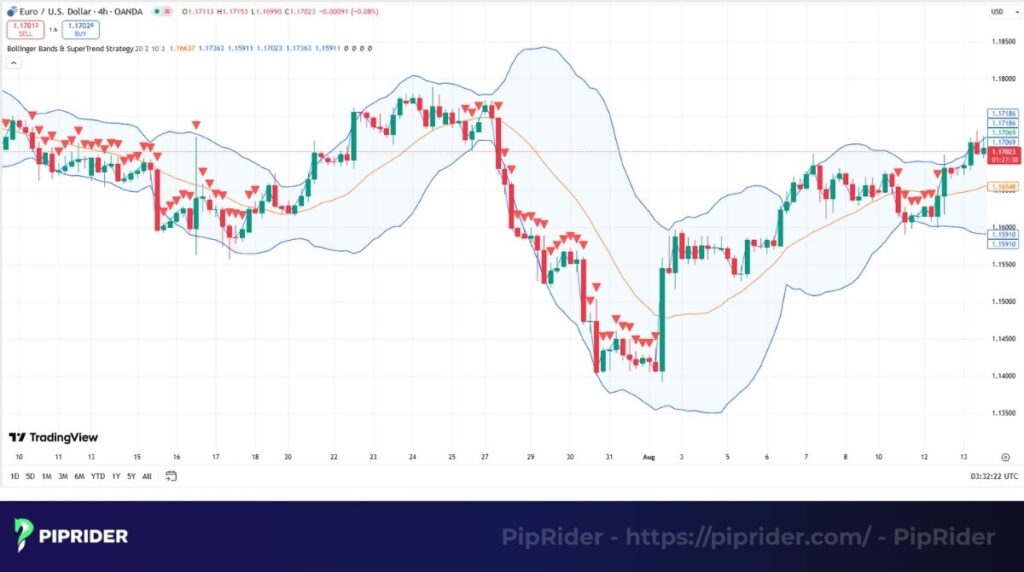
Look for a situation where the price is showing extreme behavior (touching the outer Bollinger Band), and short-term momentum (Stochastic) is reversing, all confirmed by a Supertrend flip. The principles behind the Stochastic Oscillator, as detailed on resources like Investopedia, are key here.
The strategy for a sell signal:
- Price at extreme: The price must touch or close outside the upper Bollinger Band (20, 2). This signals a statistically extreme move.
- Momentum reversal: The Stochastic Oscillator must be in the overbought zone (>80) and give a bearish crossover.
- Final confirmation: The Supertrend indicator must then flip from green to red. The confluence of three different types of signals creates a very high-probability reversal setup, far more reliable than a simple ‘super signals‘ indicator.
10. Advantages and disadvantages of Supertrend indicator
No indicator is perfect, and the Supertrend is no exception. While the indicator’s clarity makes it one of helpul tools, a trader must be brutally honest about its strengths and weaknesses. A clear understanding of both is the key to using this tool effectively.
10.1. The advantages
When used in the right market conditions, the Supertrend offers some clear and powerful benefits.
- Ease of use and visual clarity: The indicator’s greatest strength is its simplicity. Green (bullish) and red (bearish) lines are plotted directly on the chart, which makes trend interpretation instant and intuitive for new traders.
- Objective, rule-based signals: A key advantage is the removal of emotion and guesswork from trading. Signals are based on a definite price close across the line, not on opinion, which helps enforce discipline.
- Versatility and wide availability: This indicator is effective on asset classes (forex, stocks, crypto) and any timeframes. Its widespread popularity ensures that a version is readily available on almost every major trading platform.
10.2. The disadvantages
Now for the reality check. The biggest mistakes traders make with this indicator come from not understanding its inherent flaws.
- Inherent lag: The indicator will only signal a trend change after a significant move is already underway and is not designed to catch the exact top or bottom.
- Unreliability in sideways markets: The indicator’s biggest weakness is its poor performance in choppy, non-trending markets. When a market lacks a clear trend, these small price movements will constantly ‘whipsaw’ across the line, generating a series of frustrating and costly wrong signals.
11. Frequently Asked Questions (FAQs)
Here are some quick, no-nonsense answers to the questions that traders ask most often about the Supertrend indicator.
12. Conclusion
In the often-confusing world of technical analysis, the Supertrend indicator stands out for its elegant simplicity. This powerful and intuitive tool cuts through market noise by providing clear, visual signals about the primary trend direction.
While the indicator is lagging and struggles in sideways market conditions, its strength in market trends is undeniable. Using the Supertrend as a confirmation tool within a well-defined trading plan can significantly improve a trader’s ability to catch and ride major market moves.
This guide has provided the blueprint. To get started, add this tool to your charts and test a strategy in a demo account. You’ll then directly experience the objectivity this indicator can bring to your trading. To continue your journey, explore more best technical indicators in our Learn Forex category right here on Piprider.


